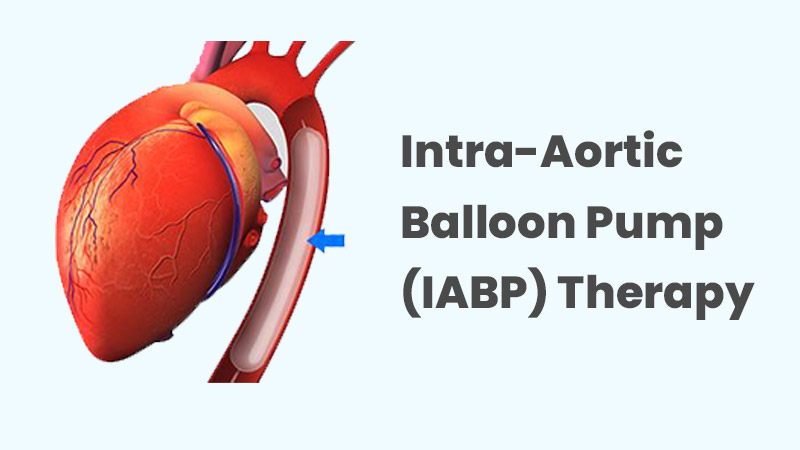List of Top Intra-Aortic Balloon Pump (IABP) Therapy doctors near by
Talk to our doctors
Intra-Aortic Balloon Pump (IABP) Therapy

When the heart is severely damaged and cannot pump a sufficient amount of blood and oxygen to the body, an Intra-Aortic Balloon Pump (IABP) emerges as a vital support system. This innovative device serves as a temporary internal pump, aiding the heart in circulating blood more efficiently.
Understanding IABP Therapy
An Intra-aortic Balloon Pump (IABP) is a mechanical device used to support heart function and improve blood flow in patients with severe heart conditions, such as acute myocardial infarction (heart attack), cardiogenic shock, or heart failure. The IABP consists of a long, flexible tube (catheter) with a balloon attached to its tip, which is inserted into the aorta, the largest artery in the body. The balloon inflates and deflates in sync with the patient's heartbeat, helping to increase blood flow to the coronary arteries and reduce the workload of the heart.
How does the IABP Work?
The IABP works by inflating and deflating the balloon at specific times during the cardiac cycle. When the heart contracts (systole), the balloon deflates, allowing blood to flow more easily from the heart into the rest of the body. During relaxation (diastole), the balloon inflates, increasing blood flow to the coronary arteries and improving oxygen delivery to the heart muscle. This synchronized pumping action helps reduce the workload of the heart and improve cardiac function.
Who Needs IABP Therapy?
IABP therapy is typically employed for individuals experiencing conditions that compromise the heart's pumping ability. Some common scenarios where IABP might be recommended include:
- Cardiogenic Shock: A life-threatening condition where the heart weakens significantly, hindering its ability to pump blood adequately.
- Myocardial Infarction (Heart Attack): IABP can be used during or after a heart attack to support the heart muscle while it recovers.
- Cardiac Surgery: IABP can be used before, during, or after certain heart surgeries to provide temporary support for the heart.
- Valve Dysfunction: In some cases of severe valve problems, IABP can be used to bridge the gap until definitive treatment is performed.
The IABP Procedure
IABP insertion is a minimally invasive procedure usually performed in a critical care setting or catheterization laboratory. Here's a breakdown of the process:
- Pre-operative Evaluation: A thorough evaluation by a qualified healthcare professional is crucial. This involves discussing your medical history, symptoms, and medications. The doctor will assess your heart function and determine if IABP therapy is the most suitable course of action.
- Preparation: On the day of the procedure, you will likely be instructed to avoid eating or drinking for several hours beforehand. Medications might be provided to ensure you're relaxed during the heart balloon pump procedure.
- The IABP Procedure: A thin catheter is inserted by the doctor into an artery in your groin. Using X-ray guidance, the catheter is carefully threaded through the artery until it reaches the aorta. A small balloon at the tip of the catheter is then inflated and deflated in sync with your heartbeat using a synchronized console. Typically, the whole intra aortic balloon pump procedure is completed in under an hour.
- IABP Therapy Duration: The duration of IABP therapy varies depending on the underlying condition and your response to treatment. The duration usually varies from a few hours to multiple days.
Living with IABP Therapy
While IABP offers valuable support, it's a temporary intervention to assist the heart's pumping function. Here's what to expect:
- Activity Restrictions: Initially, you might have certain activity limitations to prevent dislodging the catheter. Gradually, you can resume most activities as tolerated.
- Monitoring and Care: Close monitoring of your vital signs, heart function, and the IABP system is essential throughout therapy.
- Addressing the Underlying Condition: IABP therapy buys time for the heart to recover or bridges the gap until definitive treatment for the underlying heart condition is addressed.
IABP therapy serves as a critical tool in supporting the heart during times of weakness or compromised function. By assisting blood flow and allowing the heart to rest and recover, IABP can significantly improve patient outcomes. Working closely with your healthcare team and addressing the underlying heart condition is crucial for long-term heart health.
FAQ'S
It helps the heart pump blood more effectively and reduces strain on the heart.
It is used in cases of severe heart failure, after a heart attack, or during high-risk cardiac procedures.
The balloon catheter is placed in the aorta through a small incision, usually in the groin area.
Movement is limited to ensure the balloon stays in the correct position during treatment.
It is usually a temporary device, used for a few hours to a few days, depending on the patient’s condition.
Patients may feel mild discomfort during insertion, but sedation and anesthesia minimize pain.
After removal, patients are monitored closely for a short period to ensure stable heart function.
Related Blogs
Patient Reviews & FeedBack
© 2025 Kailash Healthcare Ltd. All Rights Reserved





 D. S. GambhirKailash Hospital, Noida.jpg)





.jpg.jpg)










